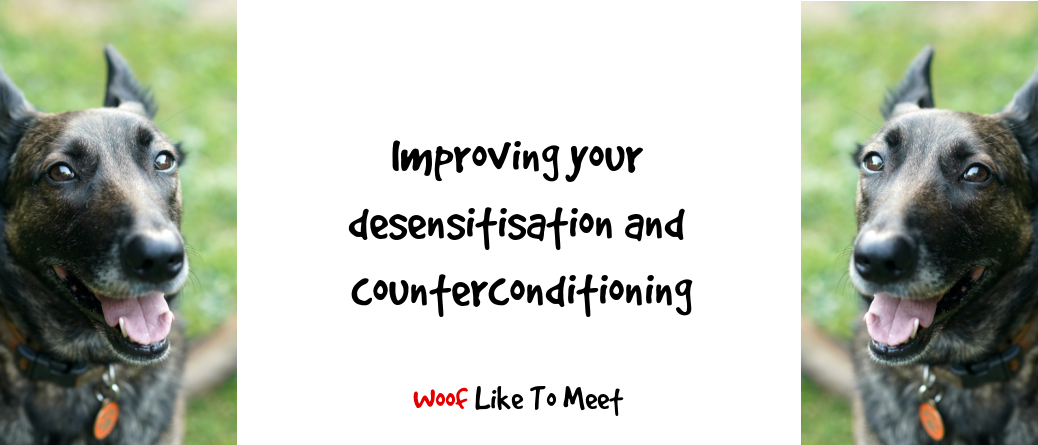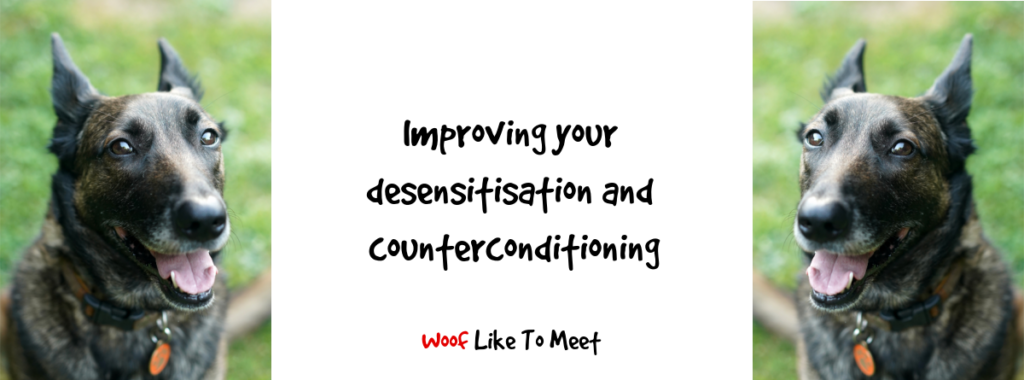
In the last few posts, I’ve been taking you through some of the training methods I use most with clients: desensitisation and counterconditioning in particular. Where there are emotional undercurrents behind the behaviour, if you don’t address them, your very best training programme in the world will fail. This is why these two skills underpin everything I do.
These two techniques – especially together – are particularly useful for dogs who are excited, fearful or aggressive. If you’ve got a chaser, a worrier or a warrior, you can no doubt put gradual desensitisation to work and add a little counterconditioning where appropriate to give things a boost.
But there are ways you can sharpen your planning and make sure your dog stays in that cool learning zone without flooding them. When you have this final piece of the puzzle down and it’s really tight, you are set up for success.
Today, we’re all about stimulus gradients!
Fancy ridiculous psychology term for a super-useful concept that will help you with your desensitisation and counterconditioning programmes.
Stimulus just means any kind of environmental thing that sets your dog off, whatever that may be.
A trigger, if you will. A cue. A thing in the world that says, “Hey, you there! Feel this amazing feeling now!”
Kind of like me when I hear the sound of an ice-cream van or the smell of sun-cream, and I feel all wonderful and summery. Or like when I feel the solemn cool air of a church or old building and I get all serious and contemplative. That kind of stuff. Chanel Number 5 making me ache to give my grandma a hug, or the smell of fresh coffee that puts me in a positive frame of mind to get on with work.
Those things are stimuli.
A gradient, then, is just a factor that determines its difficulty or easiness to cope with. For example, sun-cream makes me feel nice, but it doesn’t really compel me to do anything with that floaty-light summer feeling. If it made me so yearn for the sun that within seconds of smelling it, I booked a holiday, then that would be pretty difficult to cope with. And expensive.
It’s kind of important to understand the emotional undercurrent behind canine behaviour, but not always. That’s not what’s at stake here. I don’t really care whether the stimulus makes them feel excited, aggressive, predatory or fearful, I just care how much of it they need to be exposed to before walking them becomes like an exercise in wrestling greased pigs. I don’t even need to know what they would do if they could get to the trigger. I never know what Flika would do for instance with a field of cows, because, guess what, I never let her in a field of cows.
I mean, you know gradients, right? Those graphs from school on an incline?
Slopes, if you will.
Most people get the idea that we need to expose our dogs to stuff, and I’ve practically no client at all who has ever said to me that they haven’t already tried getting the dog used to whatever they find scary or fun or annoying.
“Tried that,” they say. “Didn’t work.”
Mostly that goes back to the fact that their dog is waaaay over threshold (see last week’s post here if you haven’t got a clue what I’m talking about) or that they are exposing their dog to far too much stuff for far too long or far too close.
Or, we were just getting it and our dogs were coping-coping-coping only for us to get far too near and boom, we’ve lost the dog to the thrill of the chase or a need to protect themselves.
Those triggers usually come in four main flavours for dogs: stuff that excites me, stuff that frightens me, stuff I want to chase and stuff that annoys me. BIG crossover between stuff that frightens me and stuff that annoys me, too. I’m just going to call that category “Stuff I Hate”.
Generally speaking, for my three, I can generally divide up their triggers into Stuff I Want To Chase, Stuff That Excites Me or Stuff I Hate.
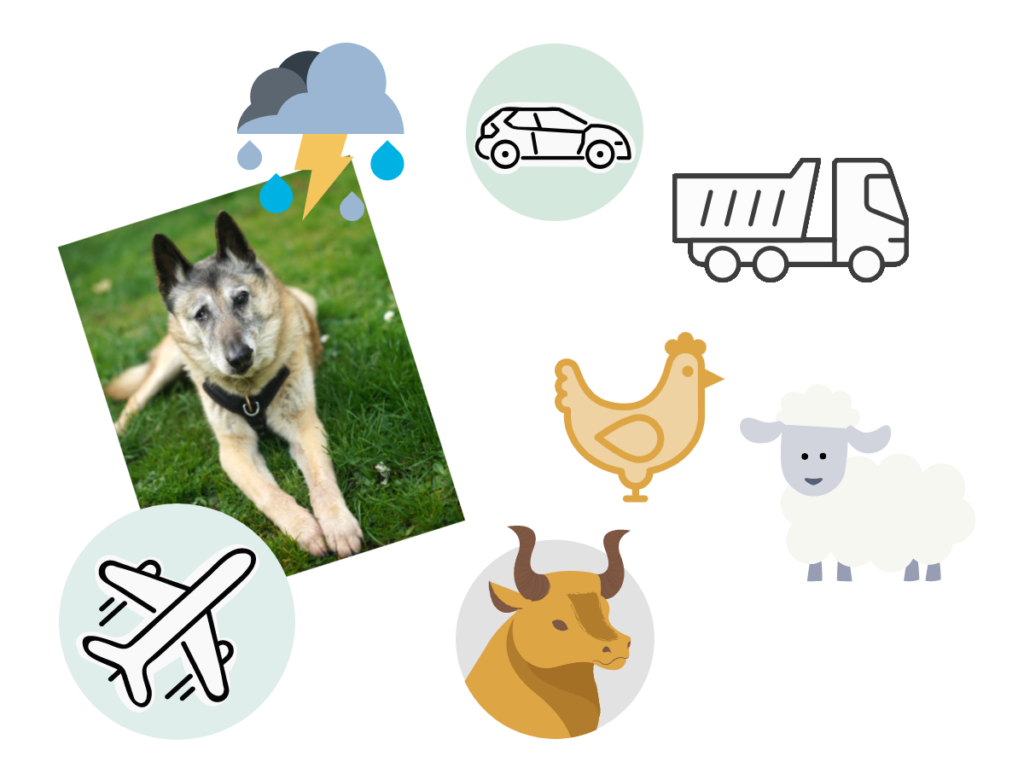
When we think about our dogs, we can think about stuff they can see that triggers an emotional response to chase, like chickens, sheep and cows do. Or like joggers, scooters, bikes and cars might. We can so think about things they can hear, like planes and thunder. We can think about things they can smell – a world that is so potent for dogs and so insignificant and puny for humans that we’re seriously in danger of massively underestimating how something smells to our dogs. Smell is everything. We put visual stuff first but stuff they can smell is much more likely to signal the proximity of those triggers.
We should also include other experiences that our individual dogs find unpleasant like being trapped, being confined, being restrained or loneliness too.
Flika is a hot mess of sixteen-year-old one-eyed neurotic chaser. I’ll refrain from sharing my theories about that here, but if stuff moves, she’s got the Way of the Shepherd: control the moving stuff, s’il vous plaît. And the more anxious she gets, the more she needs to control the moving stuff around her.
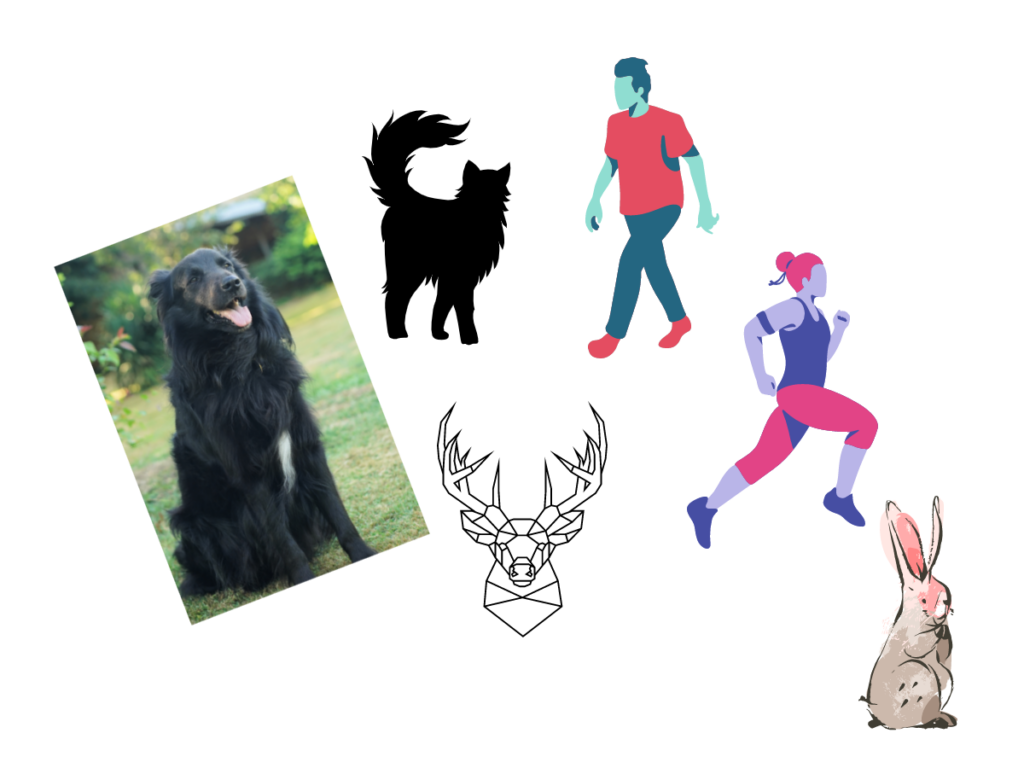
Heston is way easier and truth be told, his triggers have come and gone in his life. He’s way less bothered about stuff than he was. Chasing – well, we got past a loose flock of chickens the other day without raising our pulses, but cats set him off these days, although he lived with cats and was well socialised with all my kitten fosters over the years. Hares, yes; rabbits, no. Deer, definitely yes. It’s all about the thrill of the chase across open ground for him. He reminds me that what once did not trigger behaviours may come to, and also that dogs may get used to certain things other than others. I don’t know why he’s okay with chickens and not cats – he grew up with both and I’ve had cats in his life much more recently that he never showed an inclination to chase. He’s a very empathic dog and was always very sensitive to the kittens I had here.
And he’s still not always able to cope with people who run at him. Fair enough. Scary things.
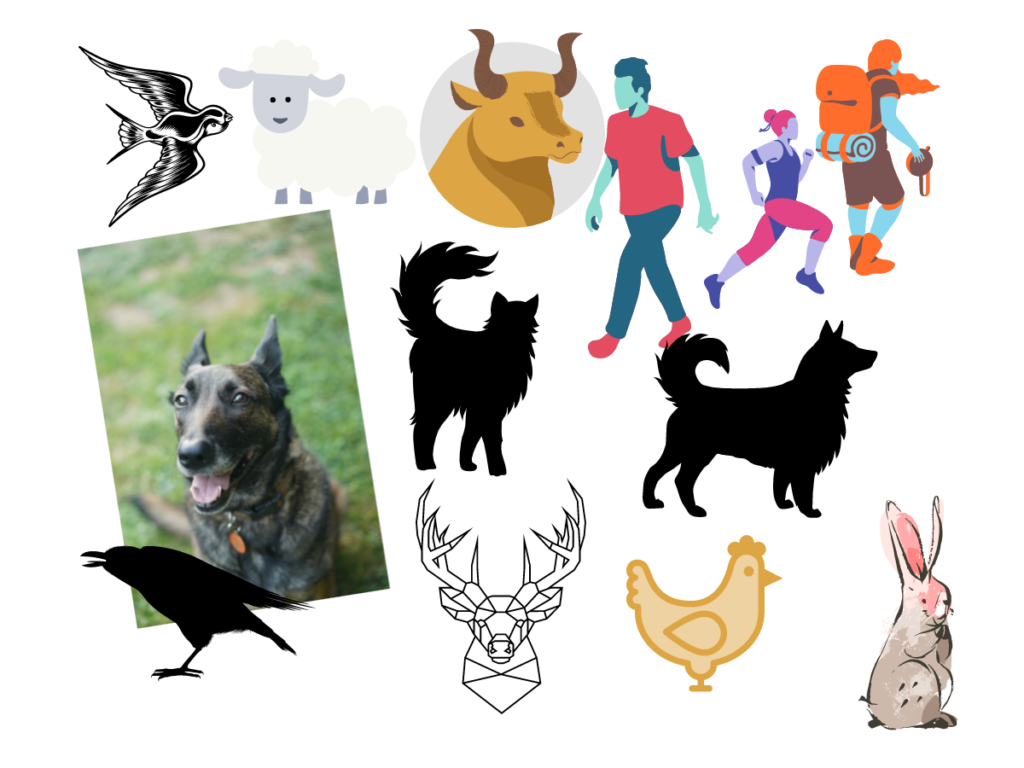
Ah, Lidy, where to start? She is nothing but a hot mess of hair triggers. The firstlings of her mind are the firstlings of her mouth, to misquote Macbeth. There’s a reason she’s here with me and not with some unsuspecting member of the public. Chasing is good. Everything from flies and lizards upwards is good to chase. And where Heston just enjoys the thrill of the chase, Lidy enjoys the thrill of the kill. So there’s that.
Then she has stuff that makes her scared. She’s on a bite-first, ask-questions-later kind of protocol. Other predators – whether they’re people or bigger dogs – scare the bejesus out of her, but she’ll fight to the death if necessary.
She’s not a fan of storms, but she habituated to gunshots and road noises and people outside the gate. She’s also less sensitive to loneliness and time alone too.
So when you’re thinking of what sets your reactive dog off, think multisensory, and start with smell. Then sounds. Then sights. Think about experiences and feelings too. Don’t get too trapped by thinking of what once triggered your dog’s emotional responses as those things may have changed.
If you like, you can categorise it as “stuff to chase” and “stuff I hate” but sometimes it’s hard to know the difference.
A stimulus gradient is the most essential part of a desensitisation programme where you’re gradually exposing your dog to those things that trigger an emotional reaction. You’re absolutely aiming to start at a point where your dog notices the thing, but where you can still get their attention. That magical threshold. But it’s not hard…. well, depending on the sense they’re using. Nose down, tail up is definitely a smell worth investigating. But this…
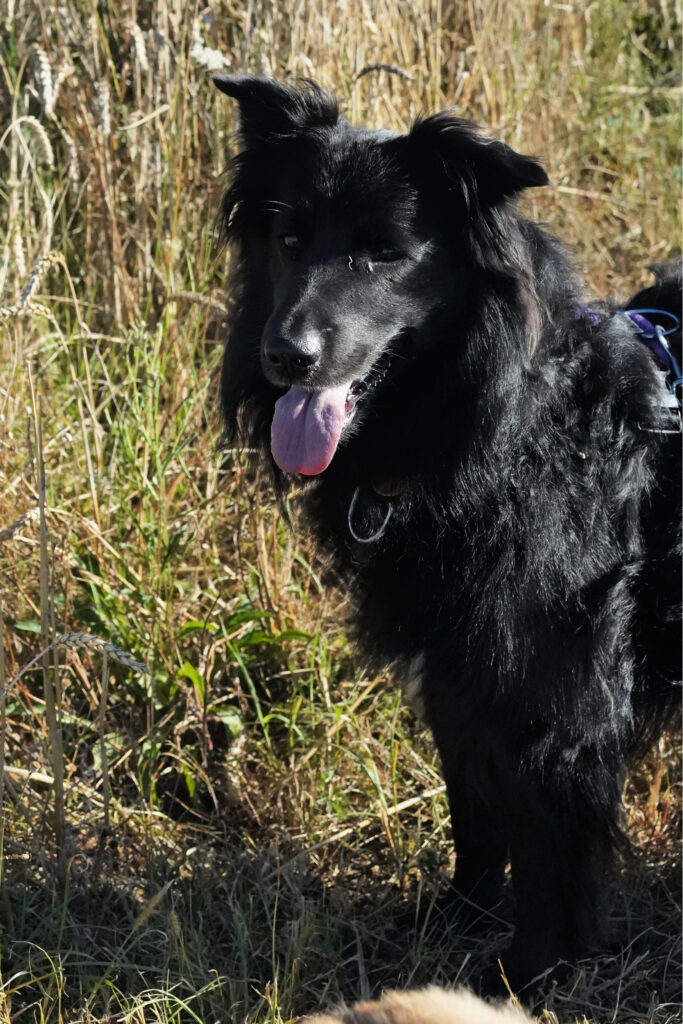
… generally means “I’ve spotted it.” It also means “I’m fine with it at that distance.”
Tongue out, mouth open, body still means “I’m not going to do anything about it just yet.”
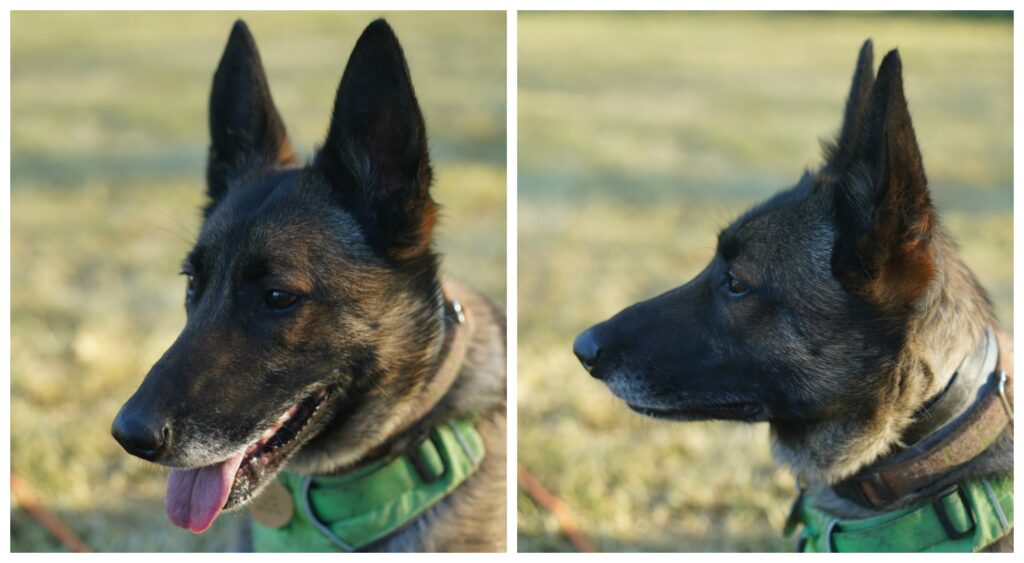
Do I need to be bothered? Not quite yet. Mouth closed, eyes focused and Heston and Lidy are in “deciding” mode.
This is the point I want to work at. Deciding phase. Thinking is still happening but give it a second, should said thing come any closer, I might not be able to get their attention any more.
Useful if you’ve got a dog who thinks with their mouth closed. Tilly usually had her mouth closed, which was not helpful at all. She had a little ear twitch and eyebrow crinkle. That was her deciding face. Know your dog’s deciding face and you’ll get to know how near is acceptable. The fewer the body parts involved in “deciding”, generally speaking the better I find it. When the whole body is involved and you’ve got a lot of energy involved in keeping them away from the trigger, then you’ve got a problem, Houston. The first thing to do though is understand your dog’s body language and make sure you’re not working too far over threshold.
Trainers usually work in two main ways around triggers: using distance and using duration. They increase the distance your dog is at related to the trigger, and then gradually decrease it. Or they start with very small amounts and then gradually increase.
But it can be so much more subtle than that, and for my mind, the more we’re aware of those subtleties, the less likely we are to write these two processes off as inefficient.
Of course we understand the basics. We understand that you need to start with the smallest amount of the thing (and yes, that includes scent).
We know that dogs don’t generalise well and we need to teach them to do what we ask of them in more and more challenging circumstances. Like if I do one lesson of loose leash walking, I’m not expecting my dog to get it straight away. Or to be able to do it in the middle of a Venetian carnival. Start small and easy, work up through multiple trials to the big stuff. We know this.
We know how to do it. Start with the smallest dose possible for your dog that the dog notices but is not showing whole body emotional responses to (like nose to tail kind of reactions). Keep under that threshold. And gradually move up that difficulty/exposure gradient without too steep an increase. That’s basically it. It’s not complex. Slow and steady wins the day.
You can see that in this link here. I massively encourage you to watch this marvellous video not least because it wasn’t an option to work under threshold with the dog, although I would say the dog isn’t massively lost in an emotional whirlwind there. Worthwhile reading the description in the post too. Really useful.
Here, the guy is working closer and closer at proximity.
You can also add another gradient: duration. That means you’re gradually exposing your dog to longer and longer periods where they can see or smell or hear their triggers.
A stimulus gradient is not just about working from low doses to high doses. There are so many ways you can alter the difficulty of the trigger. I’m going to run with my Keira Knightley example to explain. And then Miss Flika with her car chasing.

- Frequency and Rate. How often do I see the po-faced one, especially in a given period? Maybe I’d cope with once in a month, but five times a day would be too much. Fifty times in an hour would be intolerable. We can decrease the frequency or rate our dogs see their triggers for if that makes it easier. For instance, if I’m working with cars for Flika, I may only do one or two views in a day. And then I can build up to seeing lots of cars. One or two on a walk would be fine. Fifteen and I think she’d meet her limit. A steady stream and I might as well give up and go home.
- Duration. How long am I exposed to Keira? I could perhaps cope with an accidental flash of her in a Chanel printed advert if someone turns the page really quickly, but 2 hours of Anna Karenina and I’d be a gibbering wreck. And a weekend movie festival of all her most Serious Acting? Waaay beyond my skills right now. This works for dogs too – how long is a dog is exposed to things for. So you can start at the easy side of the scale. Flika can cope with short bursts of cars that come and go, but asking her to cope with really long arrivals and really long departures is just too much. When I started working with Lidy on people, the people were in view for literally a second. Then two. Then four. Then eight. When you take something the dog would like to chase, you work around that thing for a really short time at first, like the time a hare shot across the path. It was so fast, Heston was all “Was it?”. Bit different than twenty wild boar running up a 400m pathway in view for at least four minutes. A millisecond is low down on that sliding scale. You just build up to more challenging durations. But don’t push it, I will say. Coping with people for an hour when you’re not a people-friendly kind of a dog runs the risk of trigger stacking and pushing dogs over the edge.
- Interresponse time. How long between the Keiras? Back-to-back Keira-thon? Not in my lifetime. Sometimes having longer periods between seeing our triggers can give us time to get over them. Say for instance I’m on a walk with Flika and we see a car, then we have 60 minutes without one, that’s easier to cope with for her than seeing two cars with a minute break. If you know about trigger stacking, then you understand why that break is useful from a neurotransmitter and hormonal point of view, but it’s another gradient I can mess with. Building up to a minute between cars might be something we’re working on if brief intervals between occurrences are the problem. Like Heston. He tends to cope with a steady stream of neighbourhood noises, but when the gap between them is too small, he’s not truly finished coping with the last one yet.
- Response latency. How long between seeing Keira, assuming she stays at a steady distance and level of wooden-faced acting before I’m gritting my teeth and itching for the remote? How long between seeing the car, steady in the distance, and Flika starting to pull on the lead? This is another gradient I can work on – creating longer and longer gaps between seeing, smelling or hearing a trigger and then acting on it.
- Magnitude. How much po-faced Keira can I cope with? I can cope with less intense acting from Ms K, such as Bend it Like Beckham but the more she dials up the Acting and Serious Face, the less I can cope with it. The same for dogs. Lidy is really, really impossible with cats. Desensitising her to the smell of them is a start. Visuals are too much. I might have had to do this with Keira if the smell of her Chanel set me off before I’d even seen her. Work with scent if you need to. So I’ve got a slept-on set of cat blankets for Lidy. I can alter the intensity by: using blankets that have been in the same room as a cat for a minute > using blankets that have been in the same room as a cat for ten minutes > using blankets that have been in the same room as a cat for an hour > using blankets that have touched the cat for a single stroke > using blankets that have been slept on briefly > using blankets that have been slept on for longer > using blankets that have been slept on repeatedly.
I can also alter the intensity of a smell by leaving blankets longer before using them. I’ve some I’ve left out for a week. Others are fresh from the cat.
You can use intensity to start at lesser intensities with sounds (like starting on a programme for thunder or fireworks) and with smells, like the example above, and also with visual triggers too. It’s not so easy to find a hare who is willing to sleep on a blanket for 10 minutes just to desensitise a dog, and some of the synthetic prey scents that are used in the gundog world are too synthetic for Heston for example. The synthetic hare smells were not interesting to him. But you may also find dogs who need the real life sounds rather than synthetic ones on a laptop or phone (or ones created by humans compared to real sounds). For instance, Heston knows the difference between manufactured sounds of dogs barking and real dogs barking for real on my laptop. Only your dog will be able to tell you.
Making the intensity of the sight, sound or scent less is a very easy way to start at the lowest point of the gradient. - Proximity. How close am I to Ms Knightley? I might be able to stomach being 500m away in a drive-in movie, but unable to cope with sitting on the front row at the National whilst she plays Portia. We use this all the time in training programmes. How far are you away from the scary/exciting thing? Distance is your friend. I’ve written about this at length here, so I’m not going to labour the point, but I always start with the baseline that my sixteen-year-old one-eyed girl can see a car 350m away and for some dogs, working at a proximity of 750m – 900m may be necessary at first. Most humans understand gradual exposure to scary/exciting stuff really well. What we don’t understand is the distance we might need to work at to start with. I find a lot of my clients have already started these kind of things and instinctively know “ok, my dog is fine at this distance, but as soon as we get here, they snap!”. It’s about understanding the nuances of those earlier signs in many cases and also about working further back. Most of my clients’ dogs are okay up to about 20 – 50m but some need to work further back if the other stimulus gradients are at the steep end. That’s to say if they’re too intense, if they’re too fast or slow to approach and disappear, if they’re too frequent, if the rate is too high etc.
- The topography of the trigger. How’s it moving? For Keira, if I see her suck her cheeks in and gawp, that sets my teeth on edge. I can feel my buttocks clench and my fists curl. The more she looks like Munch’s The Scream, the worse it is. So smiling is easier than pouting. That’s true of dogs too. Lidy can cope with dogs who ignore her. Can’t cope at all with dogs who posture – you know, who stand there looking all hard eyeballing her. So if dogs are eyeballing her, I want to make sure the other gradients are really mild – the dog is really far away, that it’s a really brief exposure. I saw this in the vet yesterday with Flika and a very statuesque streetie from Guadaloupe. Every time Flika looked at the dog, the dog growled. When we can see that slow behaviours or inoffensive behaviours are acceptable but fast or more challenging behaviours like hard postures or direct stares are an issue, then we can mess with that gradient too. Lidy copes with squatting humans. If you’re low, you’re okay. Stand up and WHAT the absolute Devil are you Doing?!! I think I’ve had at least twenty dogs on my books who couldn’t stand people looking at them. So work with that. Not looking at all > slight look vaguely towards > more direct looking > head turned towards, eyes shut > head turned towards, eyes lowered… You get the picture. Build up to the body language that your dog finds a challenge. Like a lot of dogs are okay with cats until those beggars move. So you want to start with still cats and then slow moving cats and then … (and always, always put the cat first – if it’s not okay for the cat, it’s not acceptable to use them as a training trigger).
- Locus. Where am I most likely to react to Ms Keira? If it’s easier to cope with her in the home than in a movie cinema, start there. Similarly, dogs can be very sensitive to do with place – they know when you’re turning up the road to the vet. So start far away from where you normally see the behaviour and get gradually closer to the scene of the crime.
So when you’re thinking of your dog’s problems, those triggers (or even your own!) it’s often easy to think about what sets it off. It’s not just about distance or duration.
If we’re just thinking about how near stuff is to us or how long we’re asking dogs to cope with it, we might be missing a trick.
Imagine fireworks, for instance. Sure, I can get far away and I can try with firework sounds on tape for very short periods. But I could also try having fewer fireworks on the tape at first, and building up to more in the same timespan, having progressively shorter gaps between the fireworks on the tape, having less loud fireworks on the tapes and building up to the screamers, or considering what specific type of firework sets my dog off. Thinking about subtleties of stimulus and planning a careful and gradual gradient
In the final post in this series, I’ll talk you through how all these posts fit together to give you everything you need to help your dog problems – be it pulling on the lead, reacting to the doorbell or barking at construction workers outside your dog.

